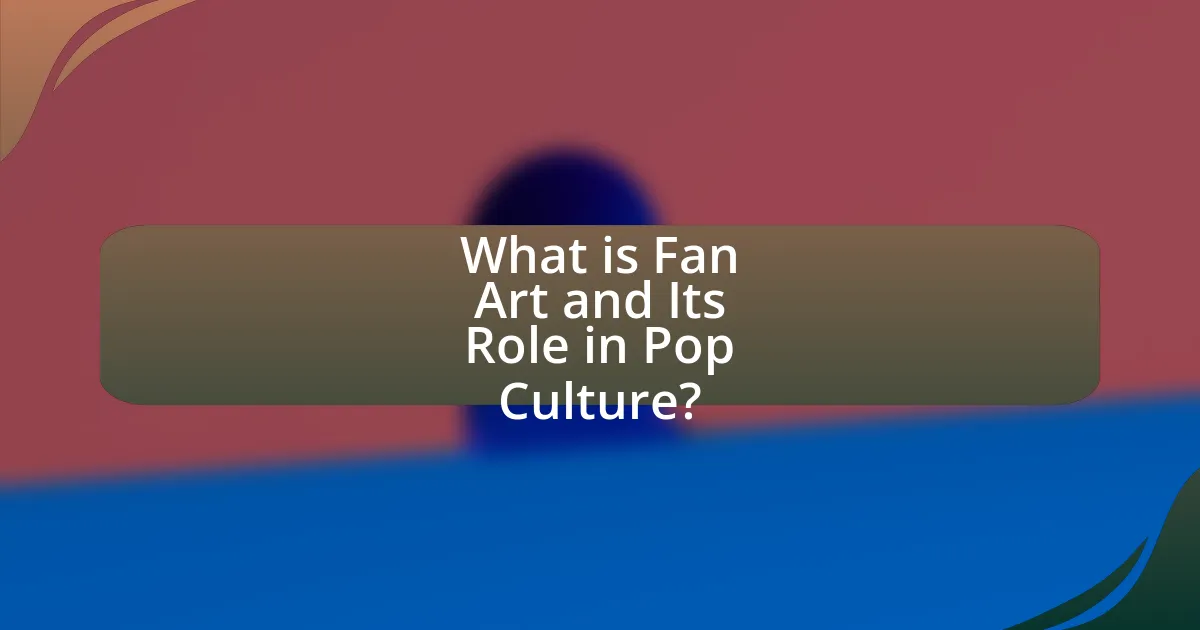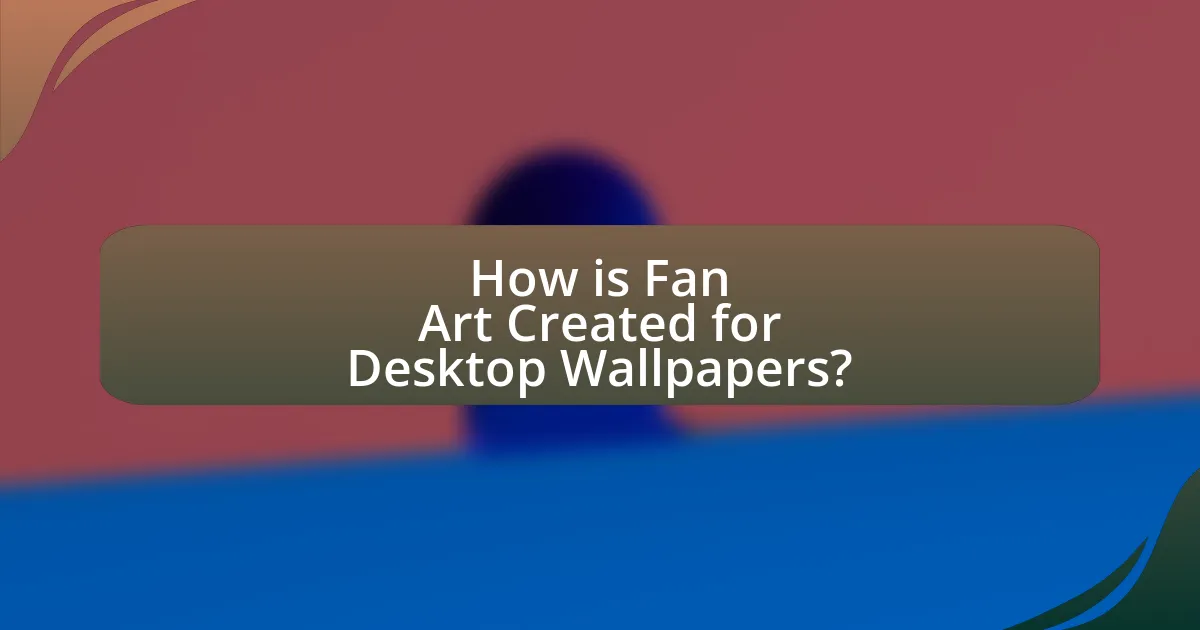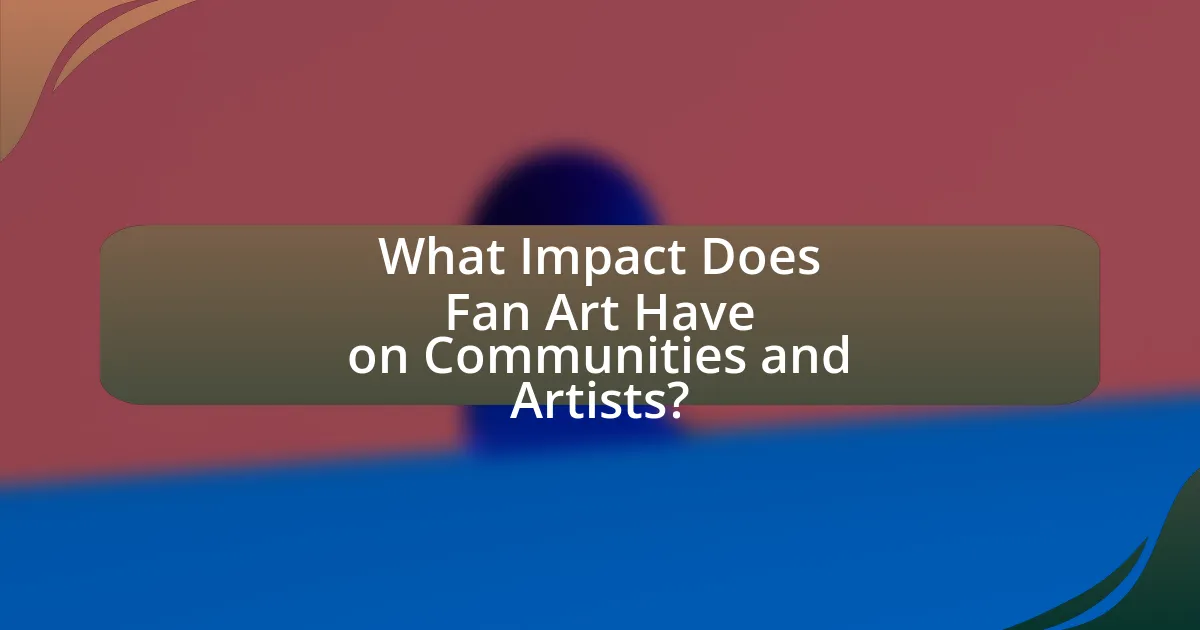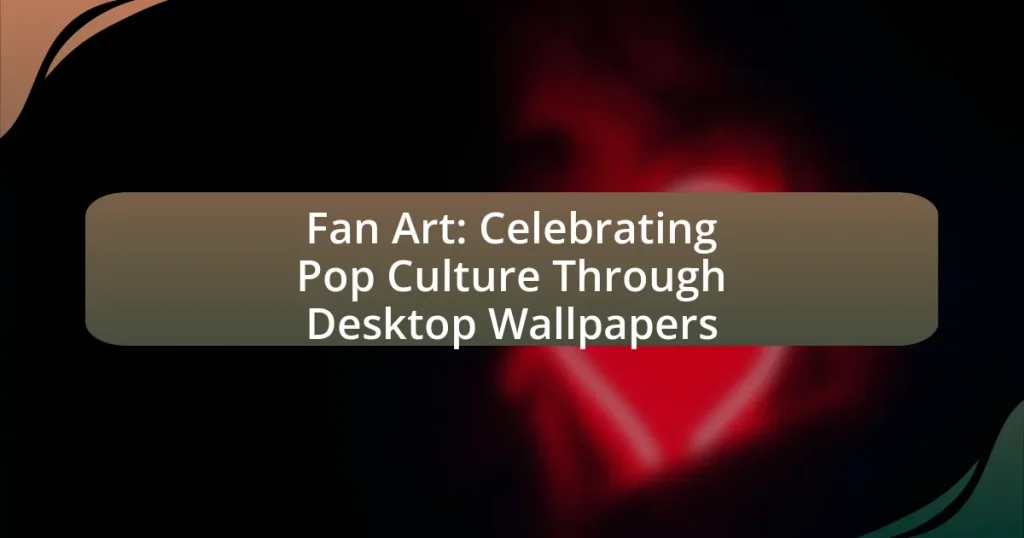Fan art is a form of artistic expression created by fans of various media franchises, including movies, video games, and books, that depicts characters and themes from those works. This article explores the significance of fan art in pop culture, highlighting its role in fostering community engagement, showcasing creativity, and contributing to cultural dialogue. It examines different forms of fan art, such as illustrations, digital art, and desktop wallpapers, while discussing the creation process, tools used, and legal considerations surrounding fan art. Additionally, the article addresses how fan art impacts communities and artists, emphasizing the opportunities it presents for collaboration, visibility, and portfolio building.

What is Fan Art and Its Role in Pop Culture?
Fan art is artwork created by fans of a particular media franchise, such as movies, video games, or books, that depicts characters, scenes, or themes from that franchise. This form of artistic expression plays a significant role in pop culture by fostering community engagement, allowing fans to showcase their creativity, and contributing to the broader cultural dialogue surrounding the original works. For instance, fan art often circulates on social media platforms, where it can gain substantial visibility and influence trends within the fandom, as seen with platforms like DeviantArt and Tumblr, which host vast collections of fan-created content.
How does fan art contribute to the celebration of pop culture?
Fan art significantly contributes to the celebration of pop culture by allowing fans to express their passion and creativity related to their favorite media. This form of artistic expression fosters community engagement, as artists share their work online, often leading to discussions and collaborations among fans. For instance, platforms like DeviantArt and social media channels have millions of fan art submissions, showcasing diverse interpretations of popular characters and themes, which reinforces the cultural significance of those works. Additionally, fan art often serves as a tribute to the original creators, enhancing the visibility and longevity of pop culture phenomena.
What are the different forms of fan art?
Different forms of fan art include illustrations, digital art, cosplay, sculptures, and fan fiction. Illustrations and digital art often depict characters or scenes from popular media, while cosplay involves dressing as characters from those works. Sculptures can be three-dimensional representations of characters, and fan fiction expands on existing narratives through written stories. Each form allows fans to express their creativity and connection to the source material, contributing to the broader fan culture.
Why is fan art significant in the context of fandoms?
Fan art is significant in the context of fandoms because it serves as a creative expression of appreciation and engagement with beloved characters and narratives. This form of art fosters community among fans, allowing them to share their interpretations and connect over shared interests. Studies have shown that fan art can enhance the emotional investment in a franchise, as it encourages participation and collaboration within the fandom, ultimately strengthening the bond between fans and the source material.
What are desktop wallpapers in the realm of fan art?
Desktop wallpapers in the realm of fan art are digital images created by artists that are designed to be used as backgrounds on computer screens. These wallpapers often feature characters, scenes, or themes from popular culture, including movies, video games, and television shows, allowing fans to express their interests visually. The popularity of fan art wallpapers is evidenced by the vast online communities and platforms where artists share their work, such as DeviantArt and ArtStation, showcasing the creativity and engagement of fans with their favorite media.
How do desktop wallpapers differ from other types of fan art?
Desktop wallpapers differ from other types of fan art primarily in their intended use and format. While fan art can encompass a wide range of mediums such as illustrations, sculptures, and animations, desktop wallpapers are specifically designed for digital display on computer screens, optimizing resolution and aspect ratio for visual clarity. This functional aspect requires wallpapers to be created with specific dimensions and resolutions, often tailored to fit various screen sizes, which is not a requirement for other fan art forms. Additionally, desktop wallpapers often emphasize aesthetic appeal and thematic representation of pop culture, serving as a backdrop for users’ digital environments, whereas other fan art may focus more on narrative or character exploration.
What themes are commonly represented in fan art wallpapers?
Common themes represented in fan art wallpapers include nostalgia, character exploration, and crossovers. Nostalgia often manifests through iconic characters and scenes from beloved media, evoking emotional connections for fans. Character exploration allows artists to depict their favorite characters in unique styles or scenarios, showcasing their personalities and relationships. Crossovers blend elements from different franchises, creating imaginative scenarios that appeal to fans of multiple series. These themes reflect the diverse interests and creativity within fan communities, as evidenced by the popularity of platforms like DeviantArt and Pinterest, where such artworks are frequently shared and celebrated.

How is Fan Art Created for Desktop Wallpapers?
Fan art for desktop wallpapers is created through a combination of artistic skills, digital tools, and inspiration from existing media. Artists typically start by selecting a theme or subject, often drawn from popular culture, such as movies, video games, or anime. They then use software like Adobe Photoshop or Procreate to design and illustrate their artwork, employing techniques such as digital painting, vector graphics, or photo manipulation.
The creation process often involves sketching initial concepts, refining the design, and adding color and details to achieve a polished final product. Many artists also consider the resolution and aspect ratio of desktop screens to ensure their wallpapers fit well on various devices. The popularity of fan art is supported by online communities and platforms where artists share their work, allowing for feedback and collaboration, which further enhances the quality and reach of their creations.
What tools and software are commonly used in creating fan art wallpapers?
Commonly used tools and software for creating fan art wallpapers include Adobe Photoshop, Corel Painter, and Procreate. Adobe Photoshop is widely recognized for its extensive features that allow artists to manipulate images and create detailed artwork. Corel Painter offers a natural painting experience with a variety of brushes and textures, making it suitable for digital painting. Procreate is favored among iPad users for its intuitive interface and powerful capabilities, enabling artists to create high-quality illustrations on the go. These tools are essential for artists to produce visually appealing fan art wallpapers that celebrate pop culture.
How do artists choose their subjects for fan art wallpapers?
Artists choose their subjects for fan art wallpapers based on personal interests, popular culture trends, and community engagement. Personal interests drive artists to depict characters or themes they are passionate about, while popular culture trends influence their choices by highlighting what is currently resonating with audiences, such as trending movies, games, or shows. Community engagement plays a crucial role, as artists often consider feedback and requests from fans, which can guide their subject selection. This approach ensures that the artwork resonates with viewers and reflects the collective enthusiasm of the fan community.
What techniques are employed in the design process?
The techniques employed in the design process of fan art for desktop wallpapers include digital illustration, photo manipulation, and vector graphics. Digital illustration allows artists to create original artwork using software like Adobe Photoshop or Procreate, enabling detailed and vibrant designs. Photo manipulation involves altering existing images to create unique compositions, often blending various elements from pop culture sources. Vector graphics, created with tools like Adobe Illustrator, provide scalability and precision, making them ideal for high-resolution wallpapers. These techniques collectively enhance the visual appeal and creativity of fan art, catering to diverse fan communities.
What are the legal considerations surrounding fan art?
The legal considerations surrounding fan art primarily involve copyright law, as fan art often incorporates characters, settings, or other elements from existing copyrighted works. Artists creating fan art may infringe on the original creator’s rights, particularly if the art is sold or distributed without permission. Fair use can apply in some cases, allowing for limited use of copyrighted material for purposes such as commentary, criticism, or parody, but this is determined on a case-by-case basis. Courts consider factors like the purpose of use, the nature of the original work, the amount used, and the effect on the market for the original work. Therefore, while fan art can be a form of creative expression, it carries potential legal risks that artists should be aware of.
How does copyright law affect fan art creation?
Copyright law significantly impacts fan art creation by protecting the original works of artists and creators, which can limit the legal use of their characters and settings in fan art. Under copyright law, the original creator holds exclusive rights to reproduce, distribute, and display their work, meaning that fan artists may face legal repercussions if they use copyrighted material without permission. For instance, in the case of “Warner Bros. Entertainment Inc. v. RDR Books,” the court ruled that unauthorized use of Harry Potter characters in a guidebook constituted copyright infringement. This legal framework necessitates that fan artists either seek permission from the original creators or create original works that do not infringe on existing copyrights, thus shaping the landscape of fan art creation.
What are the implications of sharing fan art online?
Sharing fan art online can lead to both positive and negative implications. On the positive side, it fosters community engagement and allows artists to showcase their creativity, often leading to increased visibility and support for their work. For instance, platforms like DeviantArt and Instagram have enabled artists to connect with fans and other creators, enhancing collaboration and inspiration within the fan art community.
Conversely, sharing fan art can raise legal concerns regarding copyright infringement, as original creators may not approve of the use of their characters or settings without permission. This has been highlighted in various legal cases where copyright holders have taken action against unauthorized use of their intellectual property. Additionally, artists may face challenges related to attribution and recognition, as their work can be shared widely without proper credit, undermining their rights and efforts.
Overall, the implications of sharing fan art online encompass both the celebration of creativity and the potential for legal and ethical issues.

What Impact Does Fan Art Have on Communities and Artists?
Fan art significantly enhances communities and artists by fostering creativity and collaboration. It allows artists to express their interpretations of popular culture, which can lead to increased visibility and engagement within fan communities. For instance, fan art often circulates on social media platforms, creating a shared space for fans to connect over common interests, thus strengthening community bonds. Additionally, artists who create fan art can gain recognition and build a portfolio that attracts potential clients or collaborators, as seen in the rise of artists who have transitioned from fan art to professional work in the entertainment industry. This dynamic not only enriches the artistic landscape but also cultivates a sense of belonging among fans, reinforcing the cultural significance of the original works.
How does fan art foster community engagement?
Fan art fosters community engagement by providing a platform for fans to express their creativity and share their interpretations of beloved characters and stories. This shared expression cultivates a sense of belonging among fans, as they connect over common interests and celebrate their favorite media together. For instance, online platforms like DeviantArt and social media channels allow artists to showcase their work, receive feedback, and interact with other fans, thereby strengthening community ties. Additionally, fan art often leads to collaborative projects, contests, and discussions, further enhancing engagement within the community.
What role do social media platforms play in promoting fan art?
Social media platforms play a crucial role in promoting fan art by providing artists with a global audience and facilitating community engagement. These platforms, such as Instagram, Twitter, and Tumblr, allow artists to share their work instantly, reaching millions of users who can like, comment, and share their creations. For instance, a study by the Pew Research Center found that 72% of teens use social media, making it a vital space for artists to connect with potential fans and collaborators. Additionally, hashtags and trends on these platforms help fan art gain visibility, allowing it to be discovered by users interested in specific fandoms. This interconnectedness fosters a supportive environment where artists can receive feedback, gain recognition, and even monetize their work through commissions or merchandise.
How can fan art lead to collaborations among artists?
Fan art can lead to collaborations among artists by creating a shared interest and community around a specific theme or subject. When artists produce fan art, they often engage with one another through social media platforms, art forums, or conventions, fostering connections based on mutual appreciation for the source material. This interaction can result in collaborative projects, such as joint exhibitions, anthologies, or online art challenges, where multiple artists contribute their interpretations of the same theme. For instance, events like “Inktober” encourage artists to collaborate by creating themed artwork together, showcasing their individual styles while celebrating a common interest.
What are the benefits for artists creating fan art wallpapers?
Creating fan art wallpapers provides artists with increased visibility and engagement within fan communities. By producing artwork that resonates with popular culture, artists can attract a larger audience, as fan art often circulates widely on social media and fan sites. This exposure can lead to opportunities for collaboration, commissions, and sales, enhancing the artist’s portfolio and professional network. Additionally, fan art allows artists to express their creativity and passion for specific franchises, which can foster a deeper connection with their audience. The act of creating fan art can also improve an artist’s skills through practice and experimentation with different styles and techniques.
How does fan art help artists build their portfolios?
Fan art helps artists build their portfolios by showcasing their skills and creativity in a recognizable context. By creating fan art, artists can attract attention from fans of the original work, which can lead to increased visibility and engagement on social media platforms. This visibility is crucial, as studies show that artists who actively share their work online can gain followers and potential clients more rapidly. Additionally, fan art often demonstrates an artist’s ability to replicate styles and themes, which can be appealing to art directors and potential employers looking for specific artistic capabilities.
What opportunities can arise from creating fan art?
Creating fan art can lead to various opportunities, including exposure, community engagement, and potential income. Artists can gain visibility through social media platforms, where sharing their work can attract followers and connect them with other fans and creators. Engaging with a community of like-minded individuals can foster collaboration and networking opportunities, enhancing an artist’s skills and reach. Additionally, fan art can be monetized through merchandise sales, commissions, or crowdfunding platforms, allowing artists to turn their passion into a source of income. For instance, platforms like Etsy and Redbubble enable artists to sell prints and products featuring their fan art, demonstrating the commercial potential of this creative outlet.
What are some best practices for creating and sharing fan art wallpapers?
Best practices for creating and sharing fan art wallpapers include respecting copyright laws, ensuring high-resolution images, and engaging with the community. Respecting copyright is crucial, as unauthorized use of original characters or designs can lead to legal issues; creators should seek permission or create original interpretations. High-resolution images enhance the visual quality of wallpapers, making them more appealing for users. Engaging with the community through social media platforms or fan art websites fosters collaboration and feedback, which can improve artistic skills and increase visibility. These practices contribute to a positive fan art culture while promoting creativity and respect for original works.
How can artists ensure their work is respectful of original creators?
Artists can ensure their work is respectful of original creators by obtaining permission to use their intellectual property and giving proper credit. This practice acknowledges the original creator’s rights and contributions, fostering a respectful relationship within the creative community. Additionally, artists should familiarize themselves with copyright laws and fair use guidelines to avoid infringement. For instance, the U.S. Copyright Office outlines that transformative works may qualify for fair use, but this is context-dependent and requires careful consideration. By adhering to these principles, artists can create fan art that honors the original creators while expressing their own creativity.
What platforms are best for sharing fan art wallpapers effectively?
The best platforms for sharing fan art wallpapers effectively are DeviantArt, ArtStation, and Pinterest. DeviantArt allows artists to showcase their work to a large community, providing features for high-resolution uploads and user engagement through comments and favorites. ArtStation is tailored for professional artists, offering a portfolio-style presentation that attracts industry attention and provides options for selling prints. Pinterest serves as a visual discovery platform, enabling users to share and curate collections of wallpapers, making it easy for fans to find and save their favorite art. These platforms collectively enhance visibility and engagement for fan art creators.
